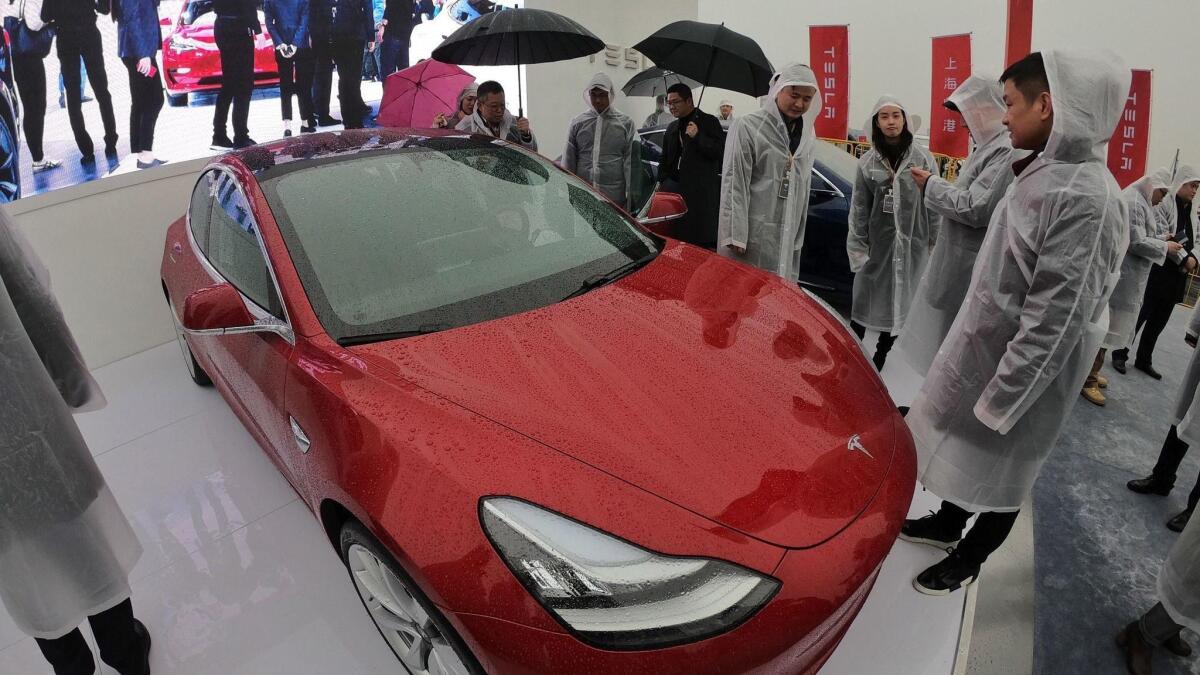Tesla layoffs loom and its stock price plunges as Musk shifts focus from growth to survival

- Share via
In an email to employees Friday, Tesla Chief Executive Elon Musk painted a dim picture of the company’s near future. He said Tesla’s cars are “still too expensive for most people,” and that to cut costs, the company would have to cut 7% of its full-time workforce.
Tesla’s stock plunged 13% on the news, closing Friday at $302.26 per share.
In the email, Musk warned employees — and, by extension, Tesla’s investors — that profit will be down in the fourth quarter and a loss in the first quarter of 2019 is possible. “Tesla must work much harder than other manufacturers to survive while building affordable, sustainable products,” Musk wrote.
That rubs against what Musk told investors last October, when the company posted a rare quarterly profit. Tesla will be profitable and have positive cash flow going forward, he said then, and would not need to raise new capital.
Musk said Friday that profit would decline in the fourth quarter, even though the company sold 7,000 more cars than in the third. Rising new-car shipments, he said, “will hopefully allow us, with great difficulty, effort, and some luck, to target a tiny profit” in the first quarter of 2019.
The blunt assessment didn’t surprise Tesla skeptics. “The company is in dire financial condition,” said Rob Majteles at Treehouse Capital. “It has been for a long time.” Majteles is one of the “short sellers” who are betting on Tesla’s stock price falling.
The assessment in an email from short-seller Mark Spiegel of Stanphyl Capital was even more withering: “I certainly wouldn’t want to own a company with a $55-billion market cap and $12 billion in debt if it had a CEO who can’t legally deny having committed securities fraud who then put out forward guidance modifying the word ‘profit’ with the words ‘hopefully, great difficulty, luck, target, and tiny.’”
Spiegel was referring to fraud charges filed last year against Musk by the Securities and Exchange Commission. Musk had driven up the stock price by claiming he had a deal to take Tesla private, which turned out not to be true. Musk settled the fraud charges without admitting or denying guilt.
Predictably, perhaps, one Tesla booster saw the bright side.
“I think it’s great,” said Ross Gerber of the Santa Monica firm Gerber Kawasaki, which owns Tesla shares and recommends the stock to its clients. “Elon needs to make Tesla a sustainable company and these are the steps toward doing that.”
Tesla has about 37,000 employees. A 7% cut would mean the layoff of more than 2,500 workers.
Although profits are important, it is cash flow alone that will determine Tesla’s success or failure this year. The layoff will preserve some capital, but won’t help Tesla avoid having to pay $920 million in convertible bonds due in March. At a stock price of $360 or above, those bondholders could convert the debt into shares. But after Friday’s rout, that target price will be much harder to achieve without some spectacularly good news.
The amount of cash on hand at Tesla will become clearer when the company releases fourth-quarter 2018 results, probably in February. At the end of the third quarter, its cash account was near $3 billion.
Cash flow depends on the success or failure of the Model 3 — 2018 can be counted as a sales success. After it emerged from crippling manufacturing problems last year, the company said it sold 145,000 Model 3s, which Musk pointed out made it “the bestselling premium vehicle of 2018 in the U.S.”
When Musk announced the Model 3 nearly three years ago, he said it would cost $35,000 before government incentives, which in California would have pushed the consumer price down to $25,000. Hundreds of thousands of people placed deposits on the car. But a profitable $35,000 Model 3 is nowhere in sight. Musk admitted Friday he must get the price tag down to everyman levels to come anywhere close to selling the 400,000 Models 3s per year he once promised.
With federal incentives on Tesla cars disappearing, the task becomes even harder.
“The need for a lower priced variant of Model 3 becomes even greater on July 1, when the U.S. tax credit again drops in half, making our car $1,875 more expensive, and again at the end of the year when it goes away entirely,” Musk wrote.
While one “mid-range” version of the Model 3 is currently available for a base price of about $45,000, adding options easily moves the price to $60,000 for most buyers.
“I’m driving the Tesla Model 3 right now,” said Tesla bull Gerber from his cellphone Friday. “It’s a $60,000 car. Elon’s right, you have a limited market for $60,000.”
As Tesla saturates the U.S. market for premium-priced Model 3s, Europe could help fill the gap. Musk said Model 3 sales will begin in Europe by February. A Tesla spokesman told The Times Friday that “we have received European vehicle type approval for Model 3,” meaning the car has passed safety tests and design regulations that allow it to be sold throughout the European Union. But competition is coming on fast: Audi, Porsche and Mercedes-Benz plan to start selling electric cars in Europe this year.
Musk also said a new China factory would open sometime this year to manufacture Model 3s for the world’s largest automobile market. But Tesla has yet to announce whether it’s got the financing needed to build the plant.
Musk ended his email by trumpeting “the most exciting product roadmap of any consumer product company in the world. Full self-driving, Model Y, Semi, Truck and Roadster on the vehicle side and Powerwall/pack and Solar Roof on the energy side are only the start.”
If strong Model 3 sales growth can’t be sustained, though, it’s unclear where the money for any of those projects will come from. Or the cash needed to afford a doubling of the company’s Supercharger network and a massive increase in its currently overloaded service centers.
News of the Tesla layoffs comes just a week after another of Musk’s companies, Hawthorne-based SpaceX, announced it would lay off about 10% of its more than 6,000 employees. SpaceX said that it needed to become “leaner” to succeed in its plans to develop Mars spacecraft as well as a network of thousands of small satellites that would provide internet access to users on Earth.
“Either of these developments, even when attempted separately, have bankrupted other organizations,” SpaceX said in the statement. “This means we must part ways with some talented and hardworking members of our team.”
Times staff writer Samantha Masunaga contributed to this report.
More to Read
Inside the business of entertainment
The Wide Shot brings you news, analysis and insights on everything from streaming wars to production — and what it all means for the future.
You may occasionally receive promotional content from the Los Angeles Times.











